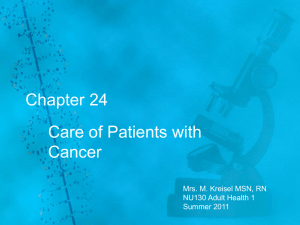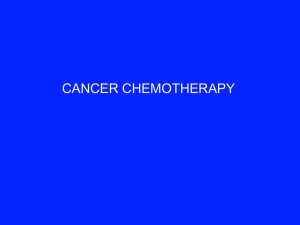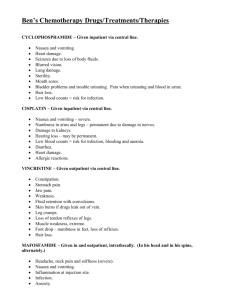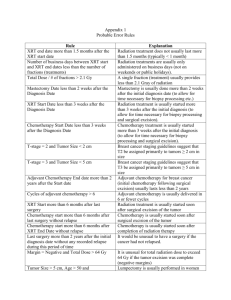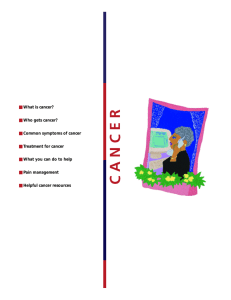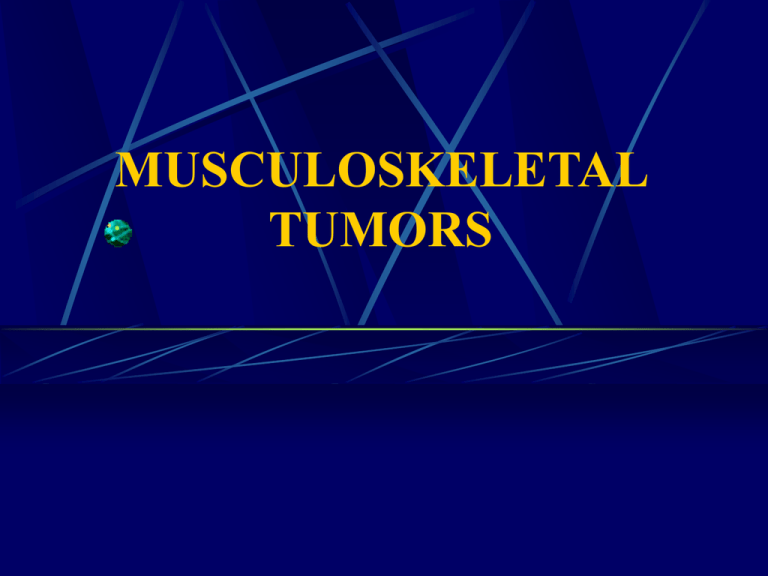
MUSCULOSKELETAL
TUMORS
Objectives
Discuss nursing care for patients with
musculoskeletal tumors.
Describe complications of treatment,
including chemotherapy, radiation and
surgery.
Overview and
Pathophysiology
Tumor-like Lesions
Benign Tumors
Malignant Tumors
#1) Mr. A has just been diagnosed with an
osteosarcoma. He shows an understanding of
his treatment options when he states:
“I accept that I have to lose my leg.”
b) “I.m glad they can take out the cancer with
such a small scar.”
c) “The chemotherapy before surgery will
shrink the tumor.”
d) “This tumor is related to the colon cancer I
had 6 years ago.”
a)
#1 Answer: c)
Rationale: Chemotherapy
and radiation are utilized
prior to surgery to shrink
the tumor and improve
chances for limb salvage.
ASSESSMENT
What is “chief complaint”?
What modalities have been attempted?
What beliefs?
What support?
Diagnostic Tests
A/P and lateral x-ray
Suspicious lesion
CT and/or MRI
X-ray/chest CT to rule
out mets
Bone scan
Lab studies
Biopsy
Open, Closed, Excisional
Arteriogram
Non-Surgical Interventions:
Chemotherapy
Shrink primary tumor, facilitate
resection
Destroy or shrink pulmonary
metastasis/micrometastasis
Evaluate efficacy of cytotoxic drugs
preoperatively
Chemotherapy
Types of drug
Routes of administration
Side Effects
Non-Surgical Interventions:
Radiation Therapy
Adjuvant bone
Palliative bone
Adjuvant soft tissue
Brachytherapy
Neuron beam therapy
Surgical Interventions:
Considerations
Amputation vs Limb Preservation
Resection / Reconstruction
#2) Mr. A has just undergone a below-theknee amputation. During his postoperative
course, measures to prevent flexion
contractures of the proximal joint include:
placing bed in reverse trendelenburg.
b) encouraging side lying position on affected side at
least t.i.d.
c) placing pillow under his thigh.
d) instructing him to maintain leg in neutral
rotation.
a)
#2 Answer: d)
Rationale: Instruct Mr. A
to maintain leg in neutral
rotation, as other positions
would not be beneficial, or
actually lead to flexion
contracture.
Nursing Diagnoses
Outcomes
Interventions
#3) Mr. Q, age 50, is preparing for removal of a
liposarcoma with reconstructive surgery. Upon discussing
pain management, Mr. Q states he had PCA-morpine
after a prior surgery, but he is concerned he will become
addicted if he uses it again. He takes one oral nonnarcotic analgesic at bedtime & no other meds. An
appropriate response would be:
a) “Maybe you should talk to the M.D. about Demerol PCA.”
b) “Please tell me more about why you think you’ll become
addicted.”
c) “I don’t think you should worry about addiction at your age.”
d) “Would it help if we gave you morphine IM rather than a
PCA?”
#3 Answer: b)
Rationale: you need to
discuss with the patient his
misconception regarding
pain management.
Pain:
Barriers to Cancer Pain
Management
Problems related to:
Healthcare professionals
Patients
Healthcare system
ABCDE Approach to Pain
A
B
C
D
E
=
=
=
=
=
Ask / Assess
Believe patient & family
Choose options
Deliver interventions
Empower / Enable
Nursing Diagnosis
Impaired physical
mobility
Outcome
Patient ambulates
independently unless
bedrest warranted
Patient verbalizes
Alteration in
comfort
decreased or relieved
pain
#4) Mr. J has been receiving preop
chemotherapy & develops stomatitis.
Dietary suggestions to help alleviate this
discomfort would include:
a) orange juice mixed with protein powder.
b) spaghetti marinara.
c) mashed potatoes with butter.
d) raw vegetables.
#4 Answer: c)
Rationale: All other
choices would exacerbate
stomatitis because they
are not bland.
Nursing Diagnosis
Outcome
Promote self-care &
Self-care deficit
Ineffective
ability to carry out
ADLs
Facilitate use of +
individual & family
coping skills
coping
Patient/s.o. find
Alteration in
means t express
sexuality
sexuality
#5) Mrs, M, age 30, has been diagnosed with
osteosarcoma of the pelvis. Which of the
following statements indicate her
understanding of the reproductive issues
which occur during chemo?
a) “I will never be able to have a baby.”
b) “My menstrual periods will remain regular.”
c) “I am worried my cancer will spread if I have sex.”
d) “My husband will continue to use condoms.”
#5 Answer: d)
Rationale: During
chemotherapy, females
undergo irregular menstrual
cycles & infertility. However,
conception is still possible &
birth control is to be used
during sexual intercourse to
prevent complications.
Nursing Diagnosis
Alteration in skin
integrity
Alteration in
emotional integrity
Outcome
Skin integrity
remains intact
Patient verbalizes
feelings freely
Perioperative Considerations
Pain management
Anemia
Wound healing
Anxiety / Loss / Depression
#6) Jim, age 15, is about to undergo
surgery for a 4cm. X 4cm. lesion
following radiation therapy. You realize
he will be at risk for a deficit in wound
healing due to:
a) prior radiation therapy.
b) large area of resection.
c) his father’s hx of wound healing problems.
d) he doesn’t like to eat breakfast.
#6 Answer: a)
Rationale: Radiation
therapy puts patients at
greater risk for wound
healing problems.
Bony Mets & Pathological
Fractures
Summary
“Life over limb”
“Communication is key”
“Caring for the patient with a
musculoskeletal tumor can combine the
‘acute’ and ‘chronic’ aspects of nursing”


